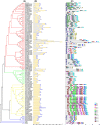The divergence and positive selection of the plant-specific BURP-containing protein family
- PMID: 30151141
- PMCID: PMC6102523
- DOI: 10.1002/ece3.1792
The divergence and positive selection of the plant-specific BURP-containing protein family
Abstract
BURP domain-containing proteins belong to a plant-specific protein family and have diverse roles in plant development and stress responses. However, our understanding about the genetic divergence patterns and evolutionary rates of these proteins remain inadequate. In this study, 15 plant genomes were explored to elucidate the genetic origins, divergence, and functions of these proteins. One hundred and twenty-five BURP protein-encoding genes were identified from four main plant lineages, including 13 higher plant species. The absence of BURP family genes in unicellular and multicellular algae suggests that this family (1) appeared when plants shifted from relatively stable aquatic environments to land, where conditions are more variable and stressful, and (2) is critical in the adaptation of plants to adverse environments. Promoter analysis revealed that several responsive elements to plant hormones and external environment stresses are concentrated in the promoter region of BURP protein-encoding genes. This finding confirms that these genes influence plant stress responses. Several segmentally and tandem-duplicated gene pairs were identified from eight plant species. Thus, in general, BURP domain-containing genes have been subject to strong positive selection, even though these genes have conformed to different expansion models in different species. Our study also detected certain critical amino acid sites that may have contributed to functional divergence among groups or subgroups. Unexpectedly, all of the critical amino acid residues of functional divergence and positive selection were exclusively located in the C-terminal region of the BURP domain. In conclusion, our results contribute novel insights into the genetic divergence patterns and evolutionary rates of BURP proteins.
Keywords: BURP proteins; functional divergence; hormone response; phylogenetic tree; positive selection; promoter region; segmental duplication; stress response; tandem duplication.
Figures


Similar articles
-
Genome-wide identification of BURP domain-containing genes in rice reveals a gene family with diverse structures and responses to abiotic stresses.Planta. 2009 Jun;230(1):149-63. doi: 10.1007/s00425-009-0929-z. Epub 2009 Apr 12. Planta. 2009. PMID: 19363683
-
Delineation of plant caleosin residues critical for functional divergence, positive selection and coevolution.BMC Evol Biol. 2014 Jun 9;14:124. doi: 10.1186/1471-2148-14-124. BMC Evol Biol. 2014. PMID: 24913827 Free PMC article.
-
Genome-wide identification and expression analysis of the BURP domain-containing genes in Gossypium hirsutum.BMC Genomics. 2019 Jul 8;20(1):558. doi: 10.1186/s12864-019-5948-y. BMC Genomics. 2019. PMID: 31286851 Free PMC article.
-
Genome-scale identification of soybean BURP domain-containing genes and their expression under stress treatments.BMC Plant Biol. 2010 Sep 13;10:197. doi: 10.1186/1471-2229-10-197. BMC Plant Biol. 2010. PMID: 20836857 Free PMC article.
-
Identification and Expression Analysis of BURP Domain-Containing Genes in Medicago truncatula.Front Plant Sci. 2016 Apr 13;7:485. doi: 10.3389/fpls.2016.00485. eCollection 2016. Front Plant Sci. 2016. PMID: 27148311 Free PMC article.
Cited by
-
De novo genome assembly and in natura epigenomics reveal salinity-induced DNA methylation in the mangrove tree Bruguiera gymnorhiza.New Phytol. 2022 Mar;233(5):2094-2110. doi: 10.1111/nph.17738. Epub 2021 Oct 16. New Phytol. 2022. PMID: 34532854 Free PMC article.
-
Peptide Crosslinking by a Class of Plant Copper Enzymes.Trends Chem. 2024 Nov;6(11):649-655. doi: 10.1016/j.trechm.2024.09.002. Epub 2024 Oct 22. Trends Chem. 2024. PMID: 39877592
-
Functional divergence and adaptive selection of KNOX gene family in plants.Open Life Sci. 2020 Jun 14;15(1):346-363. doi: 10.1515/biol-2020-0036. eCollection 2020. Open Life Sci. 2020. PMID: 33817223 Free PMC article.
-
Advanced High-Throughput Root Phenotyping and GWAS Identifies Key Genomic Regions in Cowpea During Vegetative Growth Stage.Physiol Plant. 2025 Jul-Aug;177(4):e70375. doi: 10.1111/ppl.70375. Physiol Plant. 2025. PMID: 40611537 Free PMC article.
-
The similar and different evolutionary trends of MATE family occurred between rice and Arabidopsis thaliana.BMC Plant Biol. 2016 Sep 26;16(1):207. doi: 10.1186/s12870-016-0895-0. BMC Plant Biol. 2016. PMID: 27669820 Free PMC article.
References
-
- Anisimova, M. , Bielawski J. P., and Yang Z.. 2002. Accuracy and power of Bayes prediction of amino acid sites under positive selection. Mol. Biol. Evol. 19:950–958. - PubMed
LinkOut - more resources
Full Text Sources
Other Literature Sources

